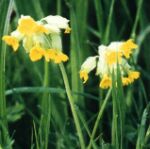| Medicinal Uses: |
Internally for bronchitis, mucus, dry cough, whooping cough, asthma, arthritis, insomnia, headache, and restlessness (especially in children). Externally for facial neuralgia, arthritic pain, skin blemishes, sunburn, and migraine.
Cowslip flower is used to treat insomnia, dizziness, headaches, bronchitis, and anxiety. Cowslip root is used to treat whooping cough, gout, bladder and kidney disease, rheumatoid arthritis, stomach cramps, and headaches. Germany's Commission E has approved the use of cowslip flower and cowslip root to treat cough and bronchitis. |
| Drug Interactions: |
| Taking cowslip these drugs may increase the drug's effects: |
| Acetazolamide, (Apo-Acetazolamide, Diamox Sequels) |
Alprazolam, (Apo-Alpraz, Xanax) |
Amiloride, (Midamor) |
Amobarbital, (Amytal) |
Aspirin and Meprobamate, (Equagesic, 292 MEP) |
| Azosemide, (Diat) |
Bumetanide, (Bumex, Burinex) |
Buspirone, (BuSpar, Nu-Buspirone) |
Butabarbital, (Butisol Sodium) |
Carpipramine, (Defecton, Prazinil) |
| Chloral Hydrate, (Aquachloral Supprettes, Somnote) |
Chlordiazepoxide, (Apo-Chlordiazepoxide, Librium) |
Chlorothiazide, (Diuril) |
Chlorthalidone, (Apo-Chlorthalidone, Thalitone) |
Clorazepate, (Tranxene, T-Tab) |
| Dexmedetomidine, (Precedex) |
Diazepam, (Apo-Diazepam, Valium) |
Diphenhydramine, (Benadryl Allergy, Nytol) |
Doxepin, (Sinequan, Zonalon) |
Estazolam, (ProSom) |
| Ethacrynic Acid, (Edecrin) |
Etozolin, (Elkapin) |
Flurazepam, (Apo-Flurazepam, Dalmane) |
Furosemide, (Apo-Furosemide, Lasix) |
Glutethimide, (Glutethimide) |
| Haloperidol, (Haldol, Novo-Peridol) |
Hydrochlorothiazide, (Apo-Hydro, Microzide) |
Hydrochlorothiazide and Triamterene, (Dyazide, Maxzide) |
Hydroflumethiazide, (Diucardin, Saluron) |
Hydroxyzine, (Atarax, Vistaril) |
| Indapamide, (Lozol, Nu-Indapamide) |
Lorazepam, (Ativan, Nu-Loraz) |
Mannitol, (Osmitrol, Resectisol) |
Mefruside, (Baycaron) |
Mephobarbital, (Mebaral) |
| Meprobamate, (Miltown, Novo-Mepro) |
Methazolamide, (Apo-Methazolamide, Neptazane) |
Methyclothiazide, (Aquatensen, Enduron) |
Metolazone, (Mykrox, Zaroxolyn) |
Midazolam, (Apo-Midazolam, Versed) |
| Olmesartan and Hydrochlorothiazide, (Benicar HCT) |
Oxazepam, (Novoxapam, Serax) |
Pentazocine, (Talwin) |
Pentobarbital, (Nembutal) |
Phenobarbital, (Luminal Sodium, PMS-Phenobarbital) |
| Polythiazide, (Renese) |
Promethazine, (Phenergan) |
Propofol, (Diprivan) |
Quazepam, (Doral) |
Secobarbital, (Seconal) |
| Spironolactone, (Aldactane, Novo-Spiriton) |
Temazepam, (Novo-Temazepam, Restoril) |
Thiopental, (Pentothal) |
Torsemide, (Demadex) |
Triamterene, (Dyrenium) |
| Triazolam, (Apo-Triazo, Halcion) |
Trichlormethiazide, (Metatensin, Naqua) |
Trifluoperazine, (Novo-Trifluzine, Stelazine) |
Urea, (Amino-Cerv, UltraMide) |
Xipamide, (Diurexan, Lumitens) |
| Zaleplon, (Sonata, Stamoc) |
Zolpidem, (Ambien) |
Zopiclone, (Alti-Zopliclone, Gen-Zopiclone) |
|

